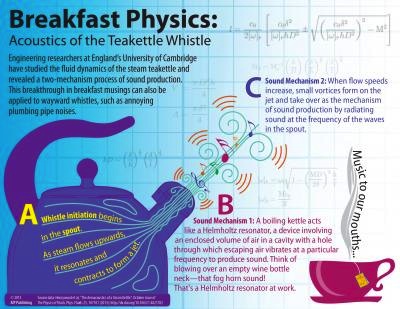
Engineering researchers at England’s University of Cambridge have studied the fluid dynamics of the steam teakettle and revealed a two-mechanism process of sound production. This breakthrough in breakfast musings can also be applied to wayward whistles, such as annoying plumbing pipe noises. (Credit: AIP Publishing.)
I still remember all the words of the song Mrs. Balzer taught my kindergarten class more than a few decades ago:
I’m a little teapot, short and stout
Here is my handle, here is my spout.
When I get all steamed up, then I shout!
Just tip me over, and pour me out.
I remember the motions, too. It was really quite charming to watch 40 five-year-olds perform the song. (For the record, I have never been short or stout. I have been known to get steamed up and shout. But that was a long time ago!)
An undergraduate at the University of Cambridge, UK, Ross Henrywood, took on the challenge of figuring out how the teakettle whistles for his fourth-year research project.
Working with UC aeroacoustics lecturer, Anurag Agarwal, Henrywood started with a literature survey and determined that the fluid dynamics mechanisms behind the whistle tone have proved elusive for more than a century. In fluid-dynamics-speak, the whistling sound is a “hole tone,” and the whistle is the kettle’s “two axially aligned orifice plates separated by a short distance at the end of the spout,” according to the paper on the research.
Few would argue to eliminate the teakettle’s comforting beckoning whistle; however, other sounds created by similar structures are unwelcome or annoying. Henrywood says in a university news story, “Pipes inside a building are one classic example, and similar effects are seen inside damaged vehicle exhaust systems. Once we know where the whistle is coming from, and what’s making it happen, we can potentially get rid of it.”
Using a series of idealized spouts, Henrywood and Agarwal determined for the first time that two fluid dynamics mechanisms produce the characteristic sound. The first regime, which occurs as steam first starts to form, is characterized by Reynolds numbers, Re, less that 2,000. In this regime, Henrywod says in the news release, “below a particular flow rate the whistle behaved like a Helmholtz resonator—the same mechanism which gives you a tone when you blow over an empty bottle.” Basically, the air inside the spout bounces around and makes a single-frequency tone.
As the steam builds and Re exceeds 2,000, the sound-generating mechanism is similar to the way sound is made in an organ tube or a flute. The news story describes the mechanism thus:
“As steam comes up the kettle’s spout, it meets a hole at the start of the whistle, which is much narrower than the spout itself. This contracts the flow of steam as it enters the whistle and creates a jet of steam passing through it. The steam jet is naturally unstable, like the jet of water from a garden hose that starts to break into droplets after it has travelled a certain distance. As a result, by the time it reaches the end of the whistle, the jet of steam is no longer a pure column, but slightly disturbed.
“These instabilities cannot escape perfectly from the whistle and as they hit the second whistle wall, they form a small pressure pulse. This pulse causes the steam to form vortices as it exits the whistle. These vortices produce sound waves, creating the comforting noise that heralds a forthcoming cup of tea.”
Armed with an understanding of the mechanisms behind the phenomenon, Henrywood and Agarwal are looking at practical (and welcome) applications for reducing noise in jet stream environments. For example, they are working on reducing the noise produced by high-speed hand dryers.
I’m all for anything that makes it easier to hear whilst the teakettle shouts for me!
The open access paper, “The aeroacoustics of a steam kettle,” is published in AIP’s Physics of Fluids (DOI: 10.1063/1.4821782).
